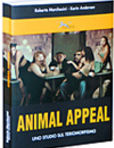李 小 鏡
Daniel Lee
MANIMALS

Animal Appeal / Uno Studio by Karen Anderson
1. In your opinion, what kind of relationship is there between humans and animals?
Scientifically, I believe Darwin’s evolution theory. I believe that humans and animals are related and the earlier we go the closer we are. If we could calculate the time when we became humans from the entire history of evolution, that’s like yesterday. Based to this calculation, I see that the wild animal’s nature has been kept inside of us still deeply.
2. What kind of personal and cultural background has brought you to work on the hybridization of humans and animals?
I grew up in Taiwan. A country was under strong culture background of ancient China and religion influence by Buddhism. But, to be honestly, I still can’t accept the Buddhist religion even I’m a kind familiar to their logic. Such as, they believe that the live reincarnation in a circle between humans, animals, demons and ferries. The comic books I used to read were full with this sort of story and characters.
3. Why did you decide to choose computer graphics as a medium?
I had my art degree major in painting but I switched to be a photographer after I fund that the camera allowing me to express myself much better then bushes. That was in the late seventies. I had gone through the still life, fashion and then people photographers in the following ten years period. At that moment, I started to see the limit of traditional photography as a tool for my creativity. I wondered that why a photographer can’t enjoy the freedom as any other artists? Therefore, I invested all of my money in computer equipment when Apple released its first personal computer (Quadra 950) which was powerful enough to manage photo image by using Adobe PhotoShop software. All of a sudden, everything I wanted before on my photograph turned out to be possible and every fantasy became a dream come true.
4. In history of art contamination between humans and animals has been often associated to evil or to the divine…
Well, it’s my weakness as a modern artist whom was trained without the traditional western art history to associate animals/humans to evil or to divine. Instead, many people in the east do believe that humans and animals are close relatives. Based to the different culture background and the believe in evolution, I see that inside the soil of humans are still contain the animals emotion or desire, more or less. In many ways, they could be humble, they could be greedy, of course, and they could also be goddess or evil too.
5. Have you ever thought that your work might influence people’s demands for plastical surgery?
Different people including filmmakers and plastic surgeon doctors have approached me before. But I don’t think it would influence people’s demands for plastic surgery. I really hope not. I think that my work just represents a new vision in photograph form. It’s only the imagination of my art. There’s no suggestion for our future.
6. What is the difference between your “manimals” and cyborg?
I think that the manimals is only an imagination suggested by an artist. It’s an interpretation between humans and animals which everybody can be expressed. Maybe, there are beings just look like manimals somewhere or some other time in our universe, but they are not cyborgs. Isn’t a cyborg should be created by a different being(s) in a real mater?
7. Do you believe that the era of uncontaminated man has ended?
I would not say that I do believe that era of uncontaminated man has ended. But, I can see that with the up speeding of recent modern science and technology, it’s getting more and more mature in search of the cloning, the human gene reconstruction, organs replacement from animals and relive again from fraying technology. With all of these concerns, I think that there is some problem say, a few hundred years later.
8. What is your future projects?
I’m about to finish my latest work “Nightlife” these days. It is a contemporary portrayal of the intrinsic animal interactions between people in today's urban environment. The setting sun often awakens a new landscape of wild life activity, one that is carefully watched by the eyes of predator, scavenger and prey.